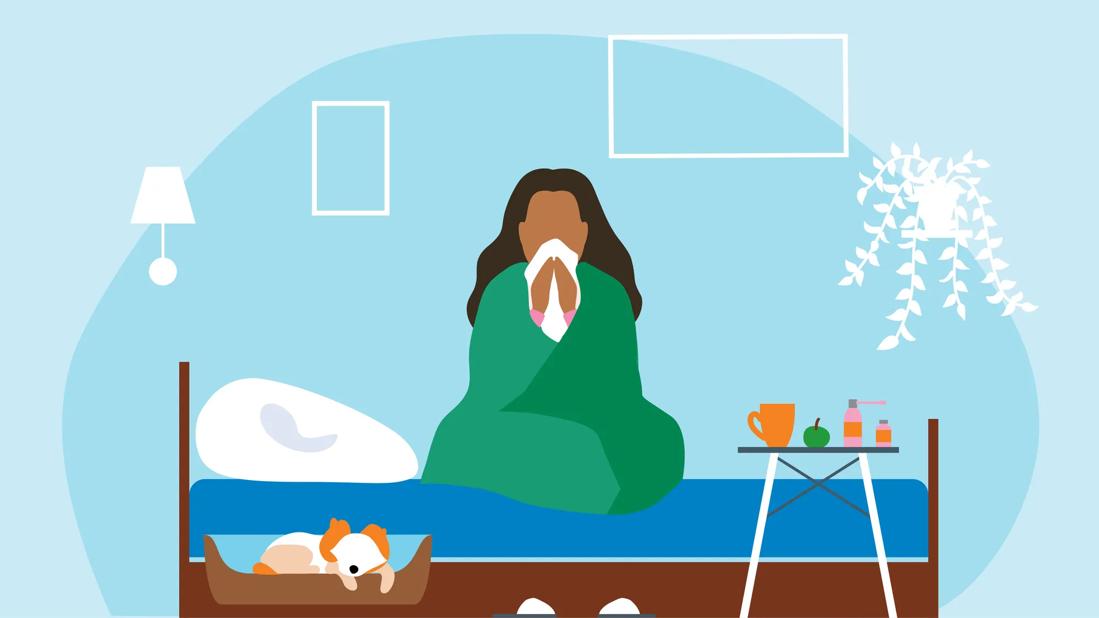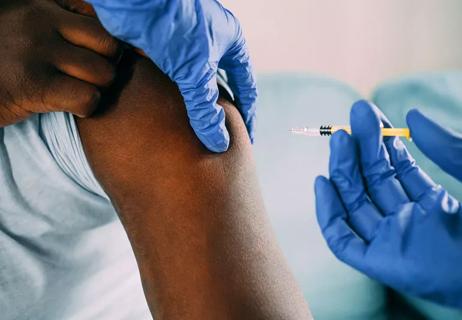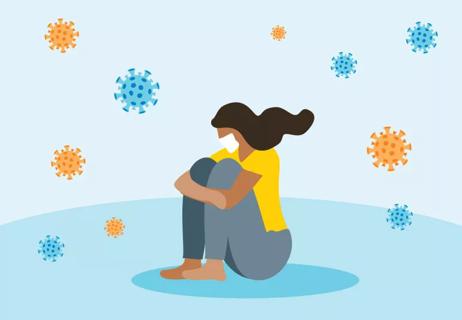You can spread the flu to others a day before you feel sick and for several days after

When the leaves change colors. When your cozy sweater comes back from its summer vacation in the back of your closet. When everything is flavored with pumpkin spice. It can only mean one thing.
Advertisement
Cleveland Clinic is a non-profit academic medical center. Advertising on our site helps support our mission. We do not endorse non-Cleveland Clinic products or services. Policy
Flu season is coming.
The flu vaccine and preventive measures like proper hand hygiene are the best defenses for protecting yourself from the many, many strains of flu. Sometimes, that pesky bug gets through anyway, though.
If you have a fever, cough and headache you can’t shake, it may be the flu. Stay home, get some rest, use over-the-counter fever-reducing medication and up your fluid intake. Call a doctor if those methods aren’t doing the trick.
But how long will you be contagious, you wonder? And when do you start being contagious? We talked with infectious disease doctor Sherif Mossad, MD, about flu contagion and how to keep from sharing your flu germs.
The Centers for Disease Control and Prevention (CDC) says the time between being exposed to the flu and when you show symptoms is usually about two days. The clock starts ticking on your ability to infect others before your symptoms even appear, though.
“You can spread the flu to others even before you know you’re sick,” Dr. Mossad says. “You can be contagious with the flu beginning about a day before you feel symptoms. You’ll be most contagious with the flu for the first three or four days after you actually feel sick. That’s why keeping your distance as much as possible for several days is important.”
Advertisement
You may continue to be infectious for a week after your symptoms start. Children and adults with weakened immune systems may be contagious even longer.
Dr. Mossad says that after recovering from the flu, your timeframe for returning to normal work and school activities may depend on your job and how frequently you interact with people. Some schools and workplaces have specific guidelines for when you can return to work after the flu or other sicknesses. Check with your employer for any specific procedures.
But a good rule of thumb, Dr. Mossad says, is to stay home until you’ve been fever-free for at least 24 hours, without using fever-reducing medications, like acetaminophen (Tylenol®).
A fever is defined as:
You should also stay home if you have other severe symptoms, such as a non-stop cough or shortness of breath.
The flu is considered a highly contagious disease. According to the CDC, the flu can circulate to others up to about 6 feet away.
And, some people can be infected with the flu without showing symptoms. Research shows that about 8% of the U.S. population gets sick from flu each season. When counting those who are carrying the virus without feeling sick, it’s believed that infection rates are closer to about 20% of the population. Even if you don’t show flu symptoms, you still can spread it to others.
Dr. Mossad explains that the flu spreads when tiny droplets of virus-laden particles are exchanged between people.
“The main way people can infect each other with flu is being in close proximity of each other,” he adds. “The infected person coughs or sneezes and tiny drops of their fluids get on my face or hands, or they land on the table we’re sharing. Then I touch my nose or my mouth, and now those virus-filled particles are in me.”
By the next day, you can start passing the flu to others. The day after that, you may start feeling ill yourself.
To keep healthy this flu season, Dr. Mossad suggests a multi-pronged approach to flu prevention.
The CDC says the first and most important step in preventing flu is to get a flu vaccine each year.
“The flu shot is your best defense against the flu,” Dr. Mossad stresses. “Studies tell us that if you get the flu vaccine, you are much less likely to have a severe illness and much less likely to be hospitalized.”
Advertisement
Research shows that, whether you realize it or not, you probably touch your face an average of 23 times each hour. Imagine all the things you’ve touched since the last time you washed your hands. Now you’re about to use those hands to rub your eyes. And chances are, without thinking about it, you’re going to do it again in about two minutes.
Washing your hands is the No. 1 way to keep viruses from elbowing their way into your body and making you sick.
Make sure you wash your hands:
Wash your hands thoroughly for about 20 seconds with soap and water. If you aren’t able to use soap and water, use an alcohol-based hand sanitizer.
Limit your opportunities for infection by:
Advertisement
The flu is a tricky virus that can find its way in, even for the most vigilant among us. If you’re sick and think it’s the flu, keep your distance to keep it to yourself. Know, too, that symptoms of the flu and symptoms of COVID-19 are easily confused. If you think you may be infected with either virus, call a healthcare provider early on. Early treatment equals better results.
“There are medications your doctor can give you to help lessen the effects of the flu,” Dr. Mossad says. “In order for them to work, you’ll want to talk with your doctor early. If you wait it out a few days, chances are you’ll already be through the worst of your symptoms anyway, so the medication isn’t going to be as helpful at that point.”
Advertisement
Learn more about our editorial process.
Advertisement

While it typically starts in October, vaccine effectiveness can affect its duration and severity

Get vaccinated, consider wearing a mask and stock your medicine cabinet

Influenza puts stress on your body and can lead to serious conditions like pneumonia or stroke

There are three antigenic types of influenza, but A and B are responsible for our flu season

Resting, staying hydrated and taking over-the-counter medicine can help you recover quickly

The antiviral medication can help curb symptoms and shorten recovery time

These nutritious foods will help your body to better fight the flu

Colds and the flu are still lurking this winter

Type 2 diabetes isn’t inevitable with these dietary changes

Applying a hot or cold compress can help with pain